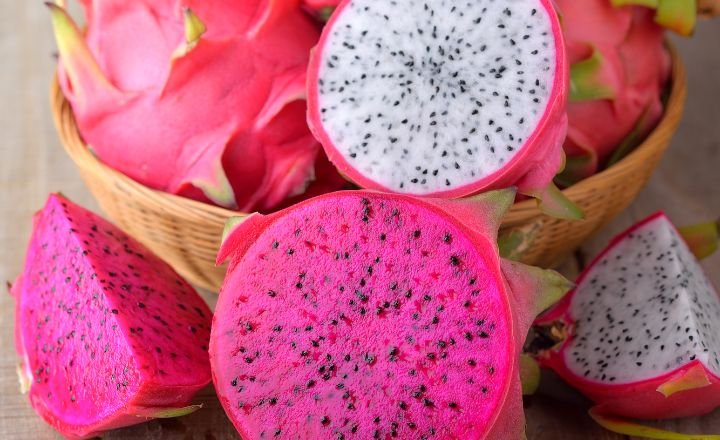Dragon fruit, or Hylocereus, is a feast for the eyes; It’s also packed with nutrients and bursting with flavour. You are known for its unique appearance and exotic taste. How to grow dragon fruit at home is a feast for the eyes; it’s a gratifying thing that brings you closer to nature, yielding fresh, delicious produce from your garden.
There are methods for cultivating this unique cactus species. It may grow through seeds, propagate through cuttings, or nurture plants in pots. Each technique has charm and benefits, making it accessible for seasoned gardeners and enthusiastic beginners.
Choosing the Right Dragon Fruit Variety
- White-fleshed dragon fruit tends to be mildly sweet with a slightly crunchy texture. It is popular among beginners due to its easy growth and robust yield.
- The red-fleshed variety is known for its intense sweetness and vibrant colour, appealing to those seeking a more exotic culinary experience.
- Yellow-fleshed dragon fruit boasts sugary notes. Its ultra-thin skin usually results in fewer pests but demands slightly warmer conditions.

Climate considerations cannot be overstated when cultivating these stunning fruits. To reach its full potential, dragon fruit thrives in well-drained soil and requires plenty of sunlight, ideally 6 to 8 hours daily.
Warmer regions with low humidity are perfect for establishing healthy plants; however, if you’re in a cooler climate or experiencing fluctuating temperatures, consider using greenhouses or planting your varieties indoors during colder months.
How to Grow Dragon Fruit from Seeds
The first crucial step in successfully growing dragon fruit from seeds is seed preparation. Start by extracting seeds from a ripe dragon fruit. Look for plump, black seeds nestled within the vibrant flesh. Rinse the seeds thoroughly to remove any fruit residue that can hinder germination.
After washing, spread the seeds out on a paper towel and allow them to dry completely for about 24 hours; this helps prevent mould during germination. If you are wondering how to grow dragon fruit in pots from seeds, choose small pots with ample drainage holes.
Fill them with a well-draining cactus or succulent mix, as excellent drainage prevents root rot. Plant your dried seeds just beneath the surface of the soil, about half an inch deep, and lightly mist them with water to create humidity, aiding germination.
The germination process typically takes 2 weeks to over a month, depending on temperature and moisture levels; maintaining warmth (around 70-90°F) significantly accelerates this timeline.
With patience and care, you’ll soon witness tiny sprouts emerging, signalling your successful venture into cultivating this exotic fruit.
How to Grow Dragon Fruit from Cuttings
Growing dragon fruit from cuttings offers a quicker and more reliable method than starting from seeds. When you propagate dragon fruit through cuttings, you retain the parent plant’s unique characteristics, ensuring your new plants produce the same delicious fruits.
This approach can result in faster growth and fruit production, often yielding harvests within a year compared to the longer waiting period seed cultivation entails.

- To obtain healthy cuttings, look for mature stems at least 12 inches long and show signs of robust growth.
- Thin, fleshy edges indicate vitality.
- After carefully taking your cutting with a sharp knife, allow it to dry for several days until the end calluses over; this prevents rot when planted.
- When you’re ready to grow, use well-draining soil and ensure it receives ample sunlight, as dragon fruit thrives in bright conditions.
For successful rooting, keep your new cutting slightly moist but not soaked. It is crucial to encourage roots while avoiding waterlogged conditions. With proper care and attention, you’ll soon be on your way to nurturing vibrant dragon fruit plants that will reward you with beautiful blossoms and exotic fruits.
How to Grow Dragon Fruit in Pots
When considering how to grow dragon fruit in pots, pot size, and material are crucial in ensuring healthy growth. Opt for a container at least 12 to 18 inches wide, allowing ample room for the roots to expand while providing stability as the plant matures.
Materials such as terracotta or concrete are recommended for their durability and breathability, which helps prevent overwatering. This is essential since dragon fruit thrives when its roots dry slightly between waterings.
Soil is another pivotal aspect of cultivating this exotic cactus in containers. A well-draining mix is vital; consider a blend of potting soil enriched with sand, perlite, or pumice to create an airy medium that mimics its native environment.
Regarding hydration and light conditions, young dragon fruit plants flourish under bright sunlight, ideally, six hours or more daily, which protects them from harsh afternoon rays during peak summer months.
When watering, allow the top inch of soil to dry out before giving it a thorough soak; this practice fosters strong root development while preventing root rot.
How to Grow Dragon Fruit Seedlings
Caring for dragon fruit seedlings after germination requires attention to their unique needs. Once your seedlings have sprouted, provide adequate light, ideally six hours of filtered sunlight daily, to promote healthy growth while avoiding the harsh midday sun that can scorch young leaves.
Keep an eye out for any signs of overcrowding; if you see two or more seedlings vying for space in a single container, it’s time to gently separate them and transplant them into individual pots.
- When it’s time to transplant your seedlings into larger pots or directly into the ground, choose a well-draining soil mix enriched with organic matter.
- This will support root development and boost nutrient availability.
- For fertilization, consider using a balanced fertilizer every four to six weeks during the growing season.
- This will help strengthen your plants and promote robust growth.
Watering should be done when the top inch of soil feels dry; be careful not to overwater, as this can lead to root rot, a common pitfall for new growers learning how to grow dragon fruit seedlings effectively. With attentive care and the right conditions, you’ll soon witness your garden bursting with vibrant dragon fruit plants.

- When considering how to plant dragon fruit in the ground, the proper soil preparation is crucial for ensuring a healthy and thriving plant.
- Dragon fruit thrives in well-draining soils that are slightly acidic to neutral, with a pH ranging from 6 to 7.
- Mixing sandy loam with organic matter like compost or peat moss can enhance drainage while providing essential nutrients.
- Avoid heavy clay soils that retain water, as they can lead to root rot and hinder growth. Choosing an ideal location for your dragon fruit garden is equally important; these vibrant plants thrive in full sunlight, requiring at least six hours of direct sun daily.
- They flourish best in areas protected from strong winds and heavy rains, which can damage their fragile stems.
Spacing is critical when planting. Each cactus should be spaced about 6 to 10 feet apart to allow room for its sprawling growth habits while maintaining optimal airflow between plants. Dig holes about two feet deep for secure anchoring; this ensures roots are well-established while promoting surface drainage.
How to Support Dragon Fruit Plants
Supporting dragon fruit plants is essential not just for structural integrity but also for maximizing yield. As a climbing cactus, dragon fruit thrives with adequate support, allowing its segmented stems to grow upright and efficiently receive sunlight.
Suitable trellises or stakes can be fashioned from materials like wood, metal, or even bamboo, each offering unique benefits in terms of durability and aesthetics. A robust vertical structure enables air circulation while minimizing the risk of disease caused by moisture buildup. Begin by gently guiding the growing stems onto your chosen support as they develop. Regularly check for excess growth.
Trimming stray branches fosters healthier plants that direct energy toward fruit production rather than excessive foliage development. Additionally, removing dead or diseased sections promotes a vibrant and productive environment.
Understanding how to best support your dragon fruit plants through proper structure and maintenance techniques sets the stage for a bountiful harvest of this exotic superfruit.
How Long Does Dragon Fruit Take to Grow?
Understanding how long dragon fruit takes to grow unveils a fascinating journey that begins with planting seedlings or cuttings. Generally, it takes about 3 to 6 years for dragon fruit plants to produce their first crop of vibrant, sweet fruits.

This timeline can vary significantly depending on climate, soil quality, and care practices. In optimal conditions, warm temperatures between 65°F and 85°F (18°C – 30°C) and well-draining soil, the growth process accelerates considerably.
The journey doesn’t end with mere planting; how you nurture the plant is crucial in its development. Regular watering, appropriate fertilization, and exposure to sunlight are vital components that can influence growth speed dramatically.
Common Issues and How to Address Them
When cultivating dragon fruit, vigilant observation is critical to thriving plants. One common issue gardeners face is pest infestations, particularly from mealybugs and scale insects that can suck the sap from your precious fruits. To combat this, consider introducing beneficial insects like ladybugs or insecticidal soap as a natural deterrent.
Regularly inspecting the undersides of leaves can help catch these pests early before they wreak havoc. Diseases such as root rot often emerge from overwatering, a critical concern given dragonfruits’ preference for well-draining soil.
Signs of overwatering typically include yellowing stems and squishy roots; addressing this requires adjusting your watering schedule and ensuring proper drainage in pots or garden beds.
Nutrient deficiencies can manifest through poor growth like ginger plant rates or discoloured leaves; a balanced fertilizer tailored for cacti can provide essential nutrients without overwhelming the plant.
Advanced Dragon Fruit Care: Boosting Growth and Yield

- Understanding Dragon Fruit Varieties
Dragon fruit, also known as pitaya, comes in a few different varieties, each with its own special traits:
- Hylocereus undatus: This one has white flesh and pink skin; it’s the most common and pretty easy to grow.
- Hylocereus costaricensis: With its red flesh and skin, this variety is known for its sweeter flavor.
- Hylocereus megalanthus: This one features white flesh and yellow skin, and it’s famous for being super sweet.
Choosing the right variety that suits your climate and taste is key to growing dragon fruit successfully.
- Optimizing Soil and Fertilization
For dragon fruit to really thrive, it needs well-draining soil with a pH level between 6 and 7.
- Mix in some organic compost or well-rotted manure to add nutrients.
- Apply a balanced fertilizer (like 10-10-10 NPK) every 4 to 6 weeks during the growing season to keep your plants healthy.
- Implementing Effective Irrigation Practices
Getting the watering just right is crucial:
- Water your plant when the top inch of soil feels dry to the touch.
- Be careful not to overwater, as this can lead to root rot; make sure your pot or ground has good drainage.
- During hot, dry spells, you might need to water more often, but always check the soil moisture first.
- Providing Structural Support
Since dragon fruit is a climbing cactus, it needs some support:
- Set up a sturdy trellis or support structure to help it grow upwards.
- Regularly tie the plant to the support to avoid damage and encourage it to climb.
- Pruning for Health and Productivity
Regular pruning is beneficial for:
- Getting rid of dead or diseased stems to keep pests at bay.
- Improving airflow, which helps reduce the risk of fungal diseases.
- Encouraging new growth, which can lead to more fruit.
- Pollination Techniques
While some varieties of dragon fruit can pollinate themselves, others need a little help:
- To hand-pollinate, use a soft brush in the evening when the flowers bloom.
- Gently transfer pollen from the stamen to the stigma to help ensure that fruit will develop.
- Pest and Disease Management
Here are some common problems you might encounter:
- Pests: You can tackle aphids, mealybugs, and ants with insecticidal soap or neem oil.
- Diseases: To prevent stem rot and fungal infections, make sure your plants have good drainage and avoid watering from above.
- Harvesting Tips
Timing is everything when it comes to harvesting for the best flavor:
- Wait until the skin of the fruit turns a deeper color and the “wings” or flaps begin to wither.
- When you’re ready to pick, use a sharp knife to cut the fruit from the stem, and be gentle to avoid any bruising.
Final Thoughts
By using these advanced care techniques, you can really boost your dragon fruit cultivation, resulting in healthier plants and a more plentiful harvest. Just remember, consistent care and a keen eye for detail are essential for successful gardening.
Conclusion
How to grow dragon fruit is an exciting and rewarding endeavour that requires just a few key steps to ensure success.t You can cultivate your vibrant cactus garden by selecting a suitable variety, providing ample sunlight and well-draining soil, and maintaining proper watering and fertilization practices.
Consistent watering and periodic fertilization will help ensure robust growth and an abundant harvest. Now that you have the essential tips, there is no better time to start your dragon fruit garden. Gather your supplies, get planting, and embark on this exciting horticultural journey today.
FAQs
Does dragon fruit need the sun to grow?
This tropical cactus thrives in warm, sunny conditions and requires at least 6 to 8 hours of direct sunlight daily.
Can I grow dragon fruit indoors?
Dragon fruit, or pitaya, thrives in bright sunlight, so it is essential to place it in a location that receives at least 6 hours of direct sunlight each day.
